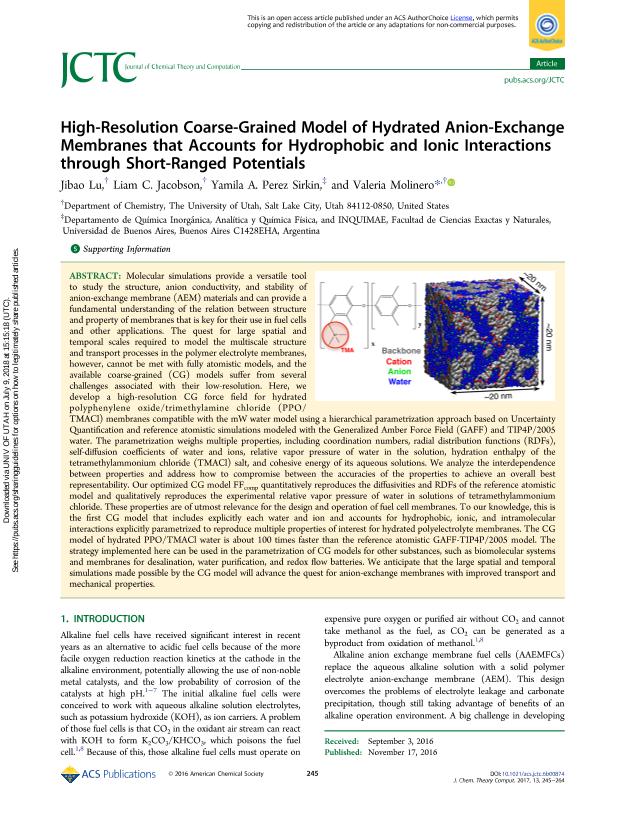Mostrar el registro sencillo del ítem
dc.contributor.author
Lu, Jibao
dc.contributor.author
Jacobson, Liam C.
dc.contributor.author
Pérez Sirkin, Yamila Anahí

dc.contributor.author
Molinero, Valeria
dc.date.available
2018-09-11T20:42:04Z
dc.date.issued
2016-11
dc.identifier.citation
Lu, Jibao; Jacobson, Liam C.; Pérez Sirkin, Yamila Anahí; Molinero, Valeria; High-resolution coarse-grained model of hydrated anion-exchange membranes that accounts for hydrophobic and ionic interactions through short-ranged potentials; American Chemical Society; Journal of Chemical Theory and Computation; 13; 1; 11-2016; 245-264
dc.identifier.issn
1549-9618
dc.identifier.uri
http://hdl.handle.net/11336/59217
dc.description.abstract
Molecular simulations provide a versatile tool to study the structure, anion conductivity, and stability of anion-exchange membrane (AEM) materials and can provide a fundamental understanding of the relation between structure and property of membranes that is key for their use in fuel cells and other applications. The quest for large spatial and temporal scales required to model the multiscale structure and transport processes in the polymer electrolyte membranes, however, cannot be met with fully atomistic models, and the available coarse-grained (CG) models suffer from several challenges associated with their low-resolution. Here, we develop a high-resolution CG force field for hydrated polyphenylene oxide/trimethylamine chloride (PPO/TMACl) membranes compatible with the mW water model using a hierarchical parametrization approach based on Uncertainty Quantification and reference atomistic simulations modeled with the Generalized Amber Force Field (GAFF) and TIP4P/2005 water. The parametrization weighs multiple properties, including coordination numbers, radial distribution functions (RDFs), self-diffusion coefficients of water and ions, relative vapor pressure of water in the solution, hydration enthalpy of the tetramethylammonium chloride (TMACl) salt, and cohesive energy of its aqueous solutions. We analyze the interdependence between properties and address how to compromise between the accuracies of the properties to achieve an overall best representability. Our optimized CG model FFcomp quantitatively reproduces the diffusivities and RDFs of the reference atomistic model and qualitatively reproduces the experimental relative vapor pressure of water in solutions of tetramethylammonium chloride. These properties are of utmost relevance for the design and operation of fuel cell membranes. To our knowledge, this is the first CG model that includes explicitly each water and ion and accounts for hydrophobic, ionic, and intramolecular interactions explicitly parametrized to reproduce multiple properties of interest for hydrated polyelectrolyte membranes. The CG model of hydrated PPO/TMACl water is about 100 times faster than the reference atomistic GAFF-TIP4P/2005 model. The strategy implemented here can be used in the parametrization of CG models for other substances, such as biomolecular systems and membranes for desalination, water purification, and redox flow batteries. We anticipate that the large spatial and temporal simulations made possible by the CG model will advance the quest for anion-exchange membranes with improved transport and mechanical properties.
dc.format
application/pdf
dc.language.iso
eng
dc.publisher
American Chemical Society

dc.rights
info:eu-repo/semantics/openAccess
dc.rights.uri
https://creativecommons.org/licenses/by-nc-sa/2.5/ar/
dc.subject
Coarse-Grained
dc.subject.classification
Otras Ciencias Químicas

dc.subject.classification
Ciencias Químicas

dc.subject.classification
CIENCIAS NATURALES Y EXACTAS

dc.title
High-resolution coarse-grained model of hydrated anion-exchange membranes that accounts for hydrophobic and ionic interactions through short-ranged potentials
dc.type
info:eu-repo/semantics/article
dc.type
info:ar-repo/semantics/artículo
dc.type
info:eu-repo/semantics/publishedVersion
dc.date.updated
2018-09-04T19:10:54Z
dc.journal.volume
13
dc.journal.number
1
dc.journal.pagination
245-264
dc.journal.pais
Estados Unidos

dc.journal.ciudad
Washington
dc.description.fil
Fil: Lu, Jibao. University of Utah; Estados Unidos
dc.description.fil
Fil: Jacobson, Liam C.. University of Utah; Estados Unidos
dc.description.fil
Fil: Pérez Sirkin, Yamila Anahí. Consejo Nacional de Investigaciones Científicas y Técnicas. Oficina de Coordinación Administrativa Ciudad Universitaria. Instituto de Química, Física de los Materiales, Medioambiente y Energía. Universidad de Buenos Aires. Facultad de Ciencias Exactas y Naturales. Instituto de Química, Física de los Materiales, Medioambiente y Energía; Argentina. Universidad de Buenos Aires. Facultad de Ciencias Exactas y Naturales. Departamento de Química Inorgánica, Analítica y Química Física; Argentina
dc.description.fil
Fil: Molinero, Valeria. University of Utah; Estados Unidos
dc.journal.title
Journal of Chemical Theory and Computation

dc.relation.alternativeid
info:eu-repo/semantics/altIdentifier/doi/https://dx.doi.org/10.1021/acs.jctc.6b00874
dc.relation.alternativeid
info:eu-repo/semantics/altIdentifier/url/https://pubs.acs.org/doi/10.1021/acs.jctc.6b00874
Archivos asociados
